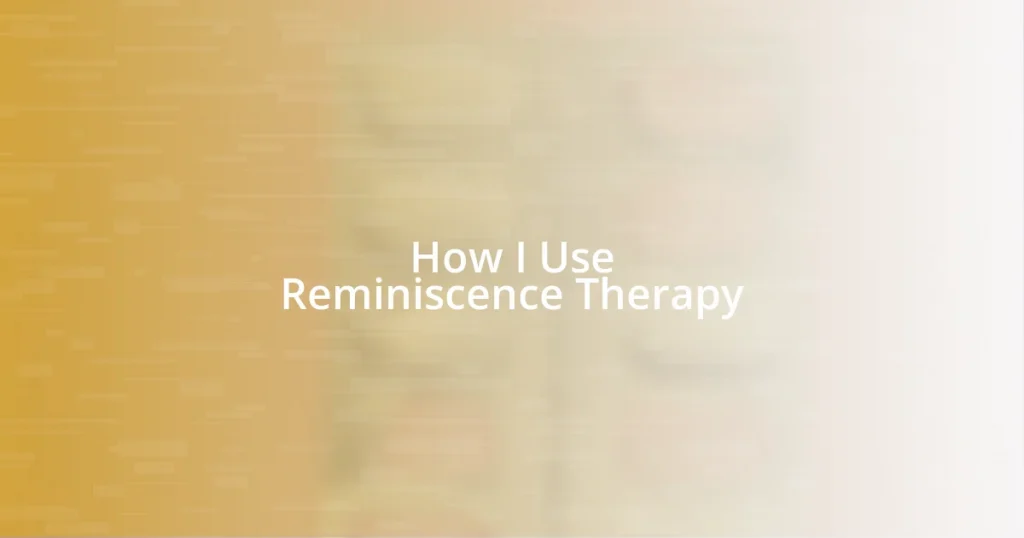Key takeaways:
- Reminiscence therapy fosters emotional connections, enhances cognitive functions, and boosts self-esteem by encouraging the sharing of personal memories.
- Choosing appropriate techniques and creating a comfortable environment are essential for promoting effective and meaningful reminiscence therapy sessions.
- Measuring success is often based on emotional transformations and participant feedback, highlighting the importance of shared experiences and insights in building community.

Understanding Reminiscence Therapy
Reminiscence therapy is a therapeutic approach that taps into the power of memories, often using discussion or prompts to evoke past experiences. I remember when my grandmother would share stories from her youth; the sparkle in her eyes showed how deeply those memories resonated. Have you ever noticed how the simple act of reminiscing can create such a strong emotional connection?
This therapy not only serves to stimulate memories but can also enhance feelings of identity and belonging. For instance, when I work with individuals, recalling significant life events often leads to joyous laughter or poignant moments of reflection. Isn’t it fascinating how revisiting our past can bring both healing and a sense of purpose?
In my experience, reminiscence therapy provides a safe space for individuals to explore both the positive and challenging moments of their lives. I once facilitated a session for a group of seniors who shared their favorite childhood games; the atmosphere was filled with energy and laughter, transforming the room into a vibrant tapestry of shared history. How could something as simple as sharing memories create such profound connections?

Benefits of Reminiscence Therapy
Reminiscence therapy can significantly boost mental well-being by reducing feelings of loneliness and isolation. I’ve seen firsthand how vivid storytelling in group settings can transform the emotional climate in a room. Once, while leading a session, one participant shared a heartfelt story about their first love, and suddenly, a wave of warmth and camaraderie filled the space as others chimed in with relatable experiences. Isn’t it remarkable how a shared memory can spark joy and foster connections?
In addition to emotional benefits, this therapy helps enhance cognitive functions. Engaging with memories often requires recall and reflection, which can help sharpen memory skills over time. During one of my sessions, I noticed that as participants revisited complex events, they began to articulate their thoughts more clearly, invigorating their communication abilities. Can you imagine how revitalizing it would be for someone to regain confidence in sharing their own stories?
Another noteworthy benefit is the promotion of self-esteem and identity. Through reminiscing, individuals not only acknowledge their past accomplishments but also feel valued for their unique experiences. I recall a moment when a participant described a life challenge they overcame, and the group rallied around them with applause, emphasizing their resilience and strength. It turned into an empowering moment that left everyone feeling uplifted. Isn’t it incredible how rediscovering one’s life events can enhance a person’s sense of self-worth?
| Benefit | Description |
|---|---|
| Emotional Connection | Reduces feelings of loneliness through shared memories and storytelling. |
| Cognitive Enhancement | Parks creativity and sharpens memory recall, improving communication skills. |
| Self-Esteem Boost | Affirms individual identity by celebrating personal experiences and resilience. |

Choosing the Right Techniques
When considering reminiscence therapy, it’s essential to select techniques that resonate with the individual’s background and emotional needs. For instance, I often gauge their interests or historical context to choose appropriate prompts. One time, I worked with a participant who loved music; so, I incorporated songs from their youth into our discussions. The result was extraordinary—songs sparked vivid memories and narratives that unfolded like a well-loved book, each page brimming with emotion.
Here are some effective techniques I’ve found particularly impactful:
- Personalized Memory Prompts: Tailor prompts to specific life events or milestones, helping individuals unlock meaningful memories.
- Multisensory Approaches: Utilize visuals, music, or scents related to past experiences to evoke deeper emotional responses.
- Storytelling Circles: Create a safe space for sharing stories, allowing participants to connect by hearing and supporting one another’s narratives.
- Photo Memory Books: Encourage individuals to bring in photographs that hold significance, as these can serve as tangible pathways to cherished memories.
- Guided Reflection: Ask open-ended questions that provoke thought and encourage reflection on pivotal life moments, promoting deeper engagement.
Choosing the right techniques is crucial for fostering a welcoming environment where reminiscing feels rewarding and safe. One particular session stands out in my memory; a participant brought in a scrapbook filled with photos. As we poured over the images together, I witnessed a transformation—a spark ignited in their eyes, reigniting confidence and joy as they recounted stories linked to those moments. It’s moments like these that truly highlight the power of choosing the right approach.

Creating a Comfortable Environment
Creating a comfortable environment is paramount for successful reminiscence therapy. In my experience, the physical space matters just as much as the heart of the activity. I once arranged a session in a cozy, sunlight-filled room with soft, inviting seating. As I watched participants settle in, the warmth of the space seemed to erase their initial hesitance. Isn’t it amazing how a comfortable chair or a beautiful view can shift the mood?
In addition to the physical setup, fostering an atmosphere of trust is crucial. During one session, I noticed an elderly woman who was typically quiet began to open up more as the others shared their stories. It struck me how crucial it was for everyone to feel safe, knowing their memories would be met with kindness, not judgment. When we prioritize empathy and support, we create a sanctuary where vulnerable feelings can emerge naturally.
Engagement plays a vital role, too. I like to include familiar elements from participants’ pasts, like classic films or beloved books, to stir nostalgia. One time, I used a vintage music playlist, and I could see the sparkle in their eyes as they recognized the tunes. It’s incredible how a simple song can evoke a multitude of emotions and warm the heart! Reflecting on these shared moments emphasizes to me that a comfortable environment isn’t just physical; it’s woven from our interactions and connections.

Developing Engaging Activities
Developing engaging activities in reminiscence therapy can truly transform the experience for participants. One of my favorite activities involves creating themed memory boxes. I once encouraged a group to gather items that reminded them of their childhood. The process was nothing short of magical; as they shared their chosen objects, laughter erupted, and stories flowed, bringing a vibrant tapestry of their past to life. Isn’t it fascinating how a simple trinket can transport someone back in time?
Incorporating games can also add a fun dynamic to sessions. I remember hosting a trivia night focused on historical events or popular culture from the participants’ younger days. The room filled with competitive spirit as they eagerly buzzed in with answers. I witnessed not only memory recall but also a boost in camaraderie among the participants. These moments are proof that activities rooted in engagement can foster connection and joy.
Lastly, I’ve found that using art can be a profound way to facilitate reminiscing. I once led a painting session where participants expressed their favorite memories through colors and shapes. The vulnerability of putting their emotions onto canvas was incredibly moving; seeing them lose themselves in creativity reminded me of the therapy’s impact. How powerful it is to translate memories into art! Through these experiences, it’s clear that engaging activities not only evoke memories but also strengthen the bonds we create in our sessions.

Measuring Success and Impact
Measuring the success of reminiscence therapy often hinges on observing the emotional transformations in participants. I recall one session where a gentleman who had initially been withdrawn gradually began to share heartfelt stories about his youth. By the end, his smile spoke louder than any statistics could; progress is sometimes best measured in the warmth of connection felt in the room.
I also look to feedback from participants to gauge impact. After a particularly engaging session focusing on family memories, I engaged in a casual chat with a participant who remarked how sharing made her feel lighter. It made me ponder: isn’t it remarkable how recalling treasured moments can lighten our emotional burden? When feedback like this emerges, it solidifies my belief that those instances of joy are the true indicators of success.
Additionally, I often use follow-up sessions to track participants’ growth over time. One memorable instance involved revisiting themes of resilience as we discussed challenges faced in their lives. Their ability to reflect not only on difficulties but also on the strength gained amazed me. It’s comforting to witness such growth—how do we quantify that emotional evolution? I’ve learned success is woven through shared stories and, ultimately, the lasting sense of community that blossoms from each session.

Sharing Experiences and Insights
Sharing experiences and insights during reminiscence therapy can be profoundly enriching. I once had the opportunity to lead a session where participants began to recount their most cherished moments. As one woman shared a story about her first dance, her eyes sparkled with nostalgia. It struck me then—how powerful our memories can be in reconnecting us with our younger selves! When we share these tales, we don’t just uncover the past; we bond over the universal experiences that shape who we are.
Reflecting on the emotions that surface during these stories is crucial. I recall a poignant moment when a gentleman spontaneously shared a memory of his late wife. His voice trembled with affection and loss, yet there was a comforting sense of relief knowing he could openly express this. Isn’t it awe-inspiring how speaking about our past can both heal wounds and celebrate love? These intimate insights foster an environment where participants feel safe to explore their emotions, building a sense of trust among the group.
Furthermore, sharing insights after each session has become integral to my practice. I remember a time when I wrapped up a meeting by inviting participants to discuss their feelings about what we’d covered. Their varied perspectives—ranging from joy to bittersweet nostalgia—helped illuminate the different ways we relate to our memories. Engaging in this dialogue not only deepens my understanding of their experiences but also enriches the group dynamic. How often do we take the time to dissect our emotions and those of others? In such moments, the therapy transcends the individual and creates a shared narrative filled with insight and understanding.















